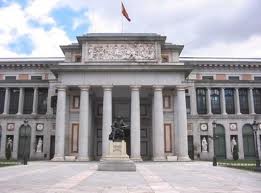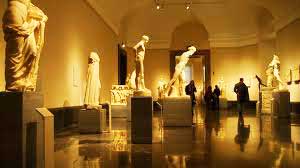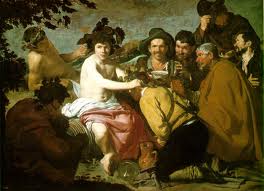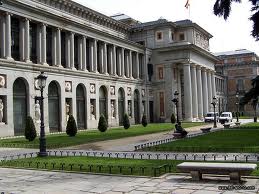Prado Museum

Where: Calle Ruiz de Alarcón 23, Madrid, 28014
Opening hours: 9 am to 8 pm from Tuesday to Sunday (including holidays. Closed on Mondays, December 25, January 1, Good Friday and May 1.
Visit Museo del Prado's website or purchase online tickets in advance
The Museum and the collection
El Prado Museum is one of the most important and visited museums in the world (9th as of 2009).
So, what makes this museum so popular?
Mainly its collection of great European masters of painting. Velázquez in particular, features prominently in the collection. Among his most famous paintings on display count Las Meninas and The Surrender of Breda. You can also enjoy plenty of works by El Greco, Titian, El Bosco, Rubens and Goya (the best represented artist in the collection), as well as important paintings of the likes of Rafael, Veronese, Murillo, Tintoretto and Van Dyck, among others.

Until very recently only 900 paintings – the most important ones – were exhibited, while as many as 7000 more were kept in storage, due to space limitations. As a matter of fact, it was said that ElPrado Museum had the biggest concentration of masterpieces per square meter. However an extension has been built (designed by Rafael Moneo) and the exhibit has been increased to over 1,150 pieces on display.
But the whole extension of Museo del Prado's collection includes over 900 sculptures, 6000 drawings, 2000 engravings, hundreds of objects of decorative art, coins and medals.
Spanish Painting: With almost 5,000 pieces, this collection is the most complete and stocked of El Prado Museum, becoming the nucleus of the permanent collection. It is also the most important collection of this school in the world. The time span it covers is from murals of the Romanesque period in the 12th century, till the end of the 19th century. El Prado has the biggest Velázquez collection in the world, and of Goya there is a very intense inventory. Presence of other important Spanish painters includes works by El Greco, Murillo and Ribera, among others.
Italian Painting: This part of the collection comprises more than 1000 paintings. There aren't many paintings belonging to the Trecento, but of the Quatrocento there are some masterpieces by Fra Angelico, Mantegna or Botticelli, as well as Antonello da Messina and Bellini. Of the Cinquecento there are paintings by Rafael, Tintoretto, Titian and Veronese, among others. The collection also includes paintings from the Italian Baroque period, including Caravaggio, Cavallino, Battistello, etc.

Flemish Painting: The Flemish painting section is the third in importance, both numerically and in terms of its quality. Like the Spanish and the Italian paintings, most of them come from the royal collection. The inventory includes the most complete collection of paintings by El Bosco in the world. But there are also paintings by Rubens, Van Dyck, Ambrosius Benson, Jan van Scorel and other masters.
Dutch Painting: The hostile situation between Spain and the United Provinces, including the Eighty Years War made it extremely difficult to bring paintings from the 17th century from what would be the Netherlands. Besides, with the newly-gained independence, Dutch painters sought to distance themselves from the classicist style: in many cases their paintings were antagonist towards the general state of monarchs from Spain and many other countries in Europe.
While in the rest of Europe the main topics chosen by painters were religious or mythological, the Dutch started depicting marine landscapes or still lifes and genre scenes, preferred by the local bourgeoisie. Due to this, the collection of Dutch paintings of the Museo del Prado's is not very extensive. Most of them were acquired in the 18th century by king Charles V (who was born in Holland). For example, there are no paintings by Johan Vermeer. There is one Rembrandt and other samples of the collection include Gabriël Metsu, Gerard Ter Borch and Adriaen van Ostade, among others.
The permanent collection of El Prado Museum includes representations of the French, German and British schools of paintings, however they are less numerous. If you are ever in Madrid to learn Spanish, you will have the chance to be in one of the cultural capitals of the world.
Museo del Prado: History
Like many other great European museums, the origins of El Prado Museum go back to the royalty, as is the case of the Louvre in Paris and the Uffizi Gallery in Florence. Its initial collection belonged to the Spanish monarchs, and it reflects many things in regards to the lives of the kings and their courts: their personal tastes, their political alliances and enmities, etc. Its collection is in no way comprehensive: while it does have representatives of all schools and times, it reflects the preferences of several generations of monarchs, including many paintings commissioned by them. Recently many more paintings have been added to the collection, which tend to balance it, but it is not to be compared with the encyclopedic style of the Louvre and the National Gallery in London.
The building that houses the Museo del Prado was designed in 1785 by architect Juan de Villanueva (who also designed the neighbouring Royal Botanic Garden and the Spanish National Observatory), commissioned by Charles III to house the Natural History Cabinet. Altogether, they would become a set of buildings that was meant to become the so-called 'Hill of Sciences'.

Designed in the style of Spanish neoclassical architecture, the construction took much longer than at first intended and the final result does not correspond exactly to the original blueprints. It was begun during the reign of King Charles III and finished in the beginning of the 19th century, under King Charles IV. However when the museum was ready it would first be destined to the Army, as a cavalry barrack when Spain was invaded by France. Consequently, it fell into disrepair long before its real life had begun, as the French even took down the zinc plates on the roof to melt them and turn them into bullets.
Despite being forgotten for a few years, Maria Isabel of Portugal, King Ferdinand VII's wife, showed an interest in the building and its project, such that its restoration began in 1818. One year later it became the Royal Painting Museum (it wouldn't get the name of El Prado for a few years, yet), which exhibited some of the best paintings owned by the Spanish royal family, which until then had been housed in the different royal palaces. Any Madrid travel guide will tell you that El Prado Museum is a must, specially to appreciate Velázquez' paintings.
The first exhibition comprised 311 paintings of the Spanish school exhibited in three halls, though there were many more paintings in storage. In the following years more paintings would be added to the collection and more exhibit halls were opened. In 1868 Queen Isabella II was dethroned, and what was once a Royal Museum now became a National Museum.
During the 21st century other museums and collections were absorbed by the Museo del Prado, such as the Museo de Arte Moderno (Modern Arts Museum), the Iconographic Museum and the Overseas Museum. The gallery also received many legacies that enlarged its catalogue of painting and other artifacts.
During the 20th century El Prado Museum had to undergo many changes to adapt to the increasing flow of tourists, specially since the 1960s. However it wasn't until the second half of the century that the Spanish government destined enough resources to improve the condition of the museum.
Temporary Collections
Museo del Prado also houses several temporary exhibitions. You may be pleasantly surprised to find a Caravaggio exhibition, or a Monet retrospective. The temporary exhibitions can last anything from 3 to 6 months, so it's good to get informed in advance.
You can visit the Museum's exhibition page to learn about the current and upcoming exhibitions. Velázquez and Goya also get their own theme exhibitions from time to time, even if the museum does house the largest permanent collection known of both Spanish painters.



